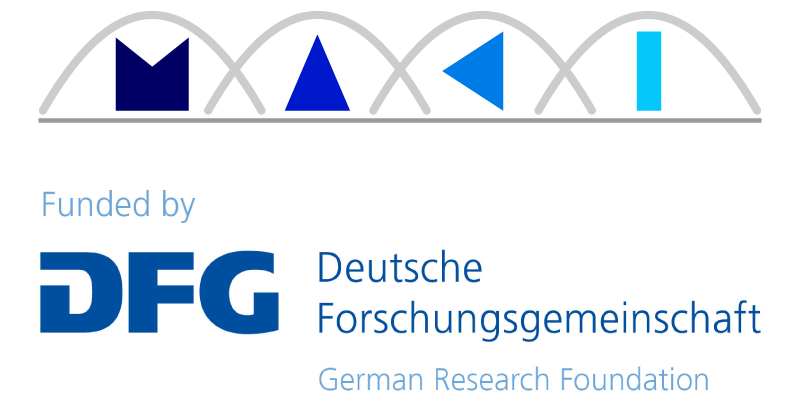Within the framework of MAKI, contributions beyond excellent scientific work are also made. For example, demonstrators were developed that were published in software repositories under free licences, data sets were made available to the scientific community or patents were applied for.
Here you can find an overview of the demonstrators developed with corresponding videos.
The CoNEXT '21 paper describes an approach to determine a lower bound for the achievable packet- and bit- rate of XDP/BPF programs offloaded onto an Netronome Agilio CX SmartNIC.
This repository contains a full implementation of the approach and all tools and data used in the evaluation.
In modern cloud environments, Distributed Stream Processing (DSP) systems are critical for enabling real-time data analysis in large-scale applications. Parallelism is often a desired property of DSP workloads to meet the timeliness and scaling requirements of current applications, necessitating the use of distributed and multi-core cloud resources. However, understanding and predicting the performance of DSP workloads is challenging due to the heterogeneous nature of cloud resources. Accurate performance modeling is essential for optimizing decisions to meet mission-critical requirements, such as timeliness, in heterogeneous environments. PDSP-Bench and ZeroTune address these challenges by providing a benchmarking system and zero-shot performance prediction models, respectively. Their results can be leveraged to perform mechanism transitions or optimize joint operator placement and parallelism to fulfill mission-critical requirements.
This demo presents PDSP-Bench, a novel benchmarking system that evaluates parallel DSP applications on heterogeneous cloud infrastructure. It addresses key limitations in existing benchmarking systems for DSP by offering enumeration for various hardware configurations and workloads. PDSP-Bench enables the benchmarking of synthetic and real-world workloads, providing deep insights into DSP system performance, e.g., the impact of parallelism across diverse streaming applications and heterogeneous hardware.
Additionally, the demo features ZeroTune, a novel learned cost model and optimizer for DSP workload parallelism tuning. Using transfer learning techniques similar to those in Large Language Models, ZeroTune provides highly accurate performance predictions and generalization for unseen workloads and hardware configurations. In addition, it uses predicted performance to optimize parallelism for unseen DSP workloads across varying cloud hardware. It significantly improves workload execution times, offering speed-ups and improved resource efficiency.
Using the heterogeneous resources of the CloudLab testbed, we showcase the scalability, accuracy, and performance benefits of PDSP-Bench and ZeroTune, demonstrating their impact on optimizing DSP systems in heterogeneous cloud environments.
We simulate and visualise a single transmitter-receiver connection. Status updates of a measured variable appear on the transmitter at random intervals, which the transmitter is to transmit to the receiver.
A short video demonstrating a ROS-based turtlebot3 that uses a DTN-ROS proxy to communicate even in challenging network conditions and uses a store, carry & forward architecture to cope with intermittent connectivity.
lectureStudio is an open and royalty-free software for e-teaching with support for Windows, Mac OS and Linux. It offers a multitude of possibilities: This starts with the presentation of PDF-based slide sets, including the possibility of pen annotations and digital whiteboards. These two features for use in interactive teaching scenarios (classroom, lecture hall) are enhanced by a quiz system with which surveys can be carried out very easily, in which the audience can participate directly by using own mobile devices in accordance with GDPR without the use of special apps or external servers. For remote teaching, recordings and bandwidth-saving live streaming are integrated directly into the software.
To further reduce the bandwidth consumption of the lectureStudio server when distributing the PDF file at the beginning of the lecture, peer-to-peer (P2P) technologies will be used in the future.
In this example, we used the GIPS framework (Graph-Based ILP Problem Specification Tool) to specify an incremental P2P-based topology control algorithm.
The goal of the algorithm is to create and manage a P2P overlay topology to connect clients to the streaming server of the lectureStudio platform. While doing so, failures in the topology (e.g., a client leaving) must also be repaired.
The video shows our workflow from research over testbed implementation to the real world.
SUN is our integrated testbed for UAV simulations, which incorporates physical world simulation with proper network emulation and even SDRs as Hardware-in-the-Loop.
We predict Wi-Fi connection loss before it drops to perform seamless vertical handovers between Wi-Fi and cellular networks. Our approach relies on data from multiple smartphone sensors such as Wi-Fi RSSI, acceleration, compass, pedometer or barometric pressure to predict connection loss. The application uses multipath TCP to dynamically switch between different wireless connection modes.
With the help of live analysis of users' head movements by sensors and historical knowledge about user behaviour, for example which areas of 360° videos were viewed most frequently, it is possible to predict which area of the video the user will view next.
This prediction can be used to load the expected viewed areas in high quality, and the areas outside this viewing area in low resolution, which can save bandwidth. A transition of these two prediction mechanisms can increase the perceived quality of the user.
ProgMP is a programming model for multipath TCP scheduling. It provides powerful abstractions for developing custom application- and preference-aware schedulers.
The Operator Placement (OP) mechanism dictates the assignment of computing units, also called operators, to the network infrastructure based on the performance goals desired by the end user. The behaviour of a placement is strongly influenced by the underlying environment, e.g. the workload of queries or the performance goals of a large number of users. For this reason, Distributed Complex Event Processing (DCEP) does not rely sufficiently on a single placement mechanism, but it can benefit from adaptive use of multiple placement mechanisms. TCEP provides this by (i) supporting key interfaces for developing OP mechanisms, (ii) enabling dynamic replacement of OP mechanisms based on user requirements, and (iii) facilitating operator deployment on a wide range of network infrastructures.
Driven by real-time applications such as IIoT, TSN and vehicular networks, the optimisation of networks and their elements in terms of latency and throughput is becoming increasingly important. With this demo, we show how latencies of network components can be identified with nanosecond accuracy using off-the-shelf P4 hardware.
We show a measured propagation speed of 5ns/m in fibre optic cables. Furthermore, our approach scales up to 100Gbit/s link speeds by aggregating many low-cost load generators into flexible software-based load generation.
Network Functions Virtualisation (NFV) on commodity hardware provides an attractive, low-cost platform to establish innovation much faster than with purpose-built hardware products. Unfortunately, implementing NFV on commodity processors does not meet the performance requirements of high-throughput data plane components in large carrier access networks. In this paper, we propose a way to provide home network access with programmable packet processing architectures. Based on the highly flexible P4 programming language, we present a design and an open-source implementation of a BNG data plane that meets the demanding requirements of broadband network gateways in carrier-grade environments.
Driven by the desire to avoid the repetitive implementation of a few scripts to run and analyse experiments, MACI evolved into a generic framework for network experiments that significantly increases efficiency and ensures reproducibility. MACI incorporates and integrates established simulators and analysis tools to promote fast but systematic network experiments. MACI significantly improved the research and development process of various communication systems.
With CoalaViz we provide a tool to make adaptation decisions in self-adaptive pervasive communication systems comprehensible and at the same time applicable to a wide range of use cases. CoalaViz (i) visualises system performance over time, (ii) visualises system state as a context feature model and graph-based network view, (iii) allows users to interactively change priorities of performance goals, and (iv) provides a modular, extensible design. We demonstrate the applicability of CoalaViz through three ubiquitous system use cases.
Flooding messages in wireless networks enables communication from one to many devices over multiple hops. Applications include route discovery in routing protocols, distributing media content to many devices, or sending control messages to perform coordinated transitions. To enable low-latency floods with efficient channel use, we use an approach where multiple devices are allowed to transmit simultaneously. Here, for broadband signals, the problem arises that simultaneous transmitters cause interference at the receiver, which continuously changes due to their frequency offsets, leading to reception errors with conventional decoders. We propose Time-Variant Zero-Forcing (TVZF) as a novel channel equalisation technique that resolves the strict time and frequency synchronisation requirements for simultaneous transmissions from multiple transmitters (MU-MISO), thus enabling low-latency flooding even with high signal bandwidths. To this end, we have developed a decoder for IEEE 802.11g that successfully decodes asynchronous MU-MISO transmissions even in practical testbed experiments with WARP software-defined radios at receive rates above 90%. In the video, we demonstrate the reconstruction of apparently time-variant channels at the receiver, which result from the respective specified combinations of time and frequency offsets of several simultaneous transmitters and their respective channels. In practice, TVZF-capable receivers can perform a transition to TVZF-based decoding as soon as the frequency offsets of the simultaneous transmitters exceed a certain value.
Nexmon is a C-based firmware patching framework for Broadcom/Cypress WiFi chips that can be used to write custom firmware patches to enable, for example, monitor mode with radotap-headers and frame-injection.



